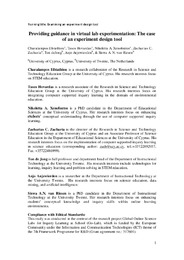| dc.contributor.author | Efstathiou, Charalampos | en |
| dc.contributor.author | Hovardas, Tasos | en |
| dc.contributor.author | Xenofontos, Nikoletta A. | en |
| dc.contributor.author | Zacharia, Zacharias C. | en |
| dc.contributor.author | deJong, Ton | en |
| dc.contributor.author | Anjewierden, Anjo | en |
| dc.contributor.author | van Riesen, Siswa A. N. | en |
| dc.contributor.editor | Johnson, T.E. | en |
| dc.contributor.editor | Lin, L. | en |
| dc.coverage.spatial | Association for Educational Communications and Technology | en |
| dc.creator | Efstathiou, Charalampos | en |
| dc.creator | Hovardas, Tasos | en |
| dc.creator | Xenofontos, Nikoletta A. | en |
| dc.creator | Zacharia, Zacharias C. | en |
| dc.creator | deJong, Ton | en |
| dc.creator | Anjewierden, Anjo | en |
| dc.creator | van Riesen, Siswa A. N. | en |
| dc.date.accessioned | 2019-02-06T10:58:58Z | |
| dc.date.available | 2019-02-06T10:58:58Z | |
| dc.date.issued | 2018 | |
| dc.identifier.issn | 1042-1629 | |
| dc.identifier.issn | 1556-6501 | |
| dc.identifier.uri | https://gnosis.library.ucy.ac.cy/handle/7/42383 | |
| dc.description.abstract | The present study employed a quasi-experimental design to assess a computerbased tool, which was intended to scaffold the task of designing experiments when using a virtual lab for the process of experimentation. In particular, we assessed the impact of this tool on primary school students’ cognitive processes and inquiry skills before and after the study’s treatment, using pre- and post-tests. Our research design involved a group of students who used the computer-based tool/scaffold to design the study’s experiments (experimental condition) and a group of students who used a paper-and-pencil worksheet as a scaffold to design the same experiments (control condition). The primary finding of the study was that the use of the computer-based experiment design tool had a more positive effect on students’ inquiry skills related to identifying variables and designing investigations than the paper-and-pencil one. This might be attributed to the functionalities provided only by the computer-based experiment design tool, which enabled students to focus their attention on crucial aspects of the task of designing experiments through (1) maintaining values for constant variables when planning experimental trials and (2) the provision of instant feedback when classifying variables into independent, dependent and controlled variables. Moreover, students in the two conditions displayed differing patterns of interactions among cognitive process and inquiry skills. Implications for designing and assessing similar computer-based scaffolds are discussed. | en |
| dc.language.iso | eng | en |
| dc.publisher | Springer US | en |
| dc.rights | info:eu-repo/semantics/openAccess | en |
| dc.rights | Open Access | en |
| dc.source | Educational Technology Research and Development | en |
| dc.source.uri | https://link.springer.com/article/10.1007%2Fs11423-018-9576-z | en |
| dc.subject | Experimental design | en |
| dc.subject | science education | en |
| dc.subject | Virtual labs | en |
| dc.subject | Inquiry skills | en |
| dc.title | Providing guidance in virtual lab experimentation: the case of an experiment design tool | en |
| dc.type | info:eu-repo/semantics/article | |
| dc.identifier.doi | 10.1007/s11423-018-9576-z | en |
| dc.description.volume | 66 | en |
| dc.description.issue | 3 | en |
| dc.description.startingpage | 767 | en |
| dc.description.endingpage | 791 | en |
| dc.type.uhtype | Article | en |
| dc.contributor.orcid | Hovardas, Tasos [0000-0003-1776-2493] | |
| dc.contributor.orcid | Zacharia, Zacharias C. [0000-0002-6381-0962] | |
| dc.gnosis.orcid | 0000-0003-1776-2493 | |
| dc.gnosis.orcid | 0000-0002-6381-0962 | |

